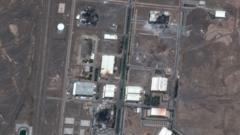In the aftermath of the devastating blast at Shahid Rajaee port in Bandar Abbas, Iranian officials are under pressure as the death toll continues to rise. Interior Minister Eskandar Momeni stated that negligence due to failures in safety precautions contributed to the tragic incident. The explosion, which occurred on Saturday, has left at least 70 people dead and injured more than 1,000.
Iran's Port Catastrophe: Negligence Cited as Death Toll Climbs

Iran's Port Catastrophe: Negligence Cited as Death Toll Climbs
Iran's interior minister identifies negligence as a key factor in a catastrophic port explosion, with fatalities now reaching 70 and over 1,000 injured.
Early investigations point to a fire igniting improperly declared cargo, resulting in an uncontrollable situation. Customs officials disclosed that the shipment involved had not been registered or duly documented prior to the explosion. The crisis management director of Hormozgan province, Mehrdad Hassanzadeh, claimed that firefighting efforts were nearing completion but acknowledged that full clearance might take up to two weeks.
Local authorities have expressed that the region affected spans nearly 1,500 hectares, encompassing significant damage to port facilities. In a contentious denouncement of foreign media, Iran’s defense ministry rejected claims linking the explosion to missile fuel chemicals, although private intelligence sources suggested that the explosive could have stemmed from the mishandling of sodium perchlorate, a material typically associated with military applications.
As rescue operations continue, anger and grief have stirred among the nation’s populace, with calls for accountability growing louder. The CEO of the firm managing the port operations described the incident as rooted in a tragic pattern of errors related to hazardous cargo declarations. Questions linger about regulatory compliance and the effectiveness of existing safety protocols at one of Iran's major commercial seaports.
Local authorities have expressed that the region affected spans nearly 1,500 hectares, encompassing significant damage to port facilities. In a contentious denouncement of foreign media, Iran’s defense ministry rejected claims linking the explosion to missile fuel chemicals, although private intelligence sources suggested that the explosive could have stemmed from the mishandling of sodium perchlorate, a material typically associated with military applications.
As rescue operations continue, anger and grief have stirred among the nation’s populace, with calls for accountability growing louder. The CEO of the firm managing the port operations described the incident as rooted in a tragic pattern of errors related to hazardous cargo declarations. Questions linger about regulatory compliance and the effectiveness of existing safety protocols at one of Iran's major commercial seaports.






















